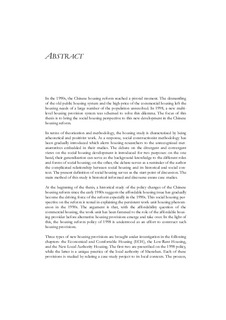| dc.description.abstract | In the 1990s, the Chinese housing reform reached a pivotal moment. The dismantling of the old public housing system and the high price of the commercial housing left the housing needs of a large number of the population unresolved. In 1998, a new multilevel housing provision system was schemed to solve this dilemma. The focus of this thesis is to bring the social housing perspective to this new development in the Chinese housing reform.
In terms of theorization and methodology, the housing study is characterized by being atheoretical and positivist work. As a response, social constructionist methodology has been gradually introduced which alerts housing researchers to the unrecognized metanarratives embedded in their studies. The debate on the divergent and convergent views on the social housing development is introduced for two purposes: on the one hand, their generalization can serve as the background knowledge to the different roles and forms of social housing; on the other, the debate serves as a reminder of the author the complicated relationship between social housing and its historical and social context. The present definition of social housing serves as the start point of discussion. The main method of this study is historical-informed and discourse-aware case studies.
At the beginning of the thesis, a historical study of the policy changes of the Chinese housing reform since the early 1980s suggests the affordable housing issue has gradually become the driving force of the reform especially in the 1990s. This social housing perspective on the reform is tested in explaining the persistent work-unit housing phenomenon in the 1990s. The argument is that, with the affordability question of the commercial housing, the work-unit has been fastened to the role of the affordable housing provider before alternative housing provisions emerge and take over. In the light of this, the housing reform policy of 1998 is understood as an effort to construct such housing provisions.
Three types of new housing provisions are brought under investigation in the following chapters: the Economical and Comfortable Housing (ECH), the Low-Rent Housing, and the New Local Authority Housing. The first two are prescribed on the 1998 policy, while the latter is a unique practice of the local authority of Shenzhen. Each of these provisions is studied by relating a case-study project to its local contexts. The process, product and performance are analyzed in terms of their beneficiaries, affordability, and land, planning and design features.
Serving as the housing for the mid- and low-income population, ECH in Beijing has encountered difficulties, both in targeting the desired population and regulating the affordability. The reasons are the multi-intentions attached to it and the conflicting expectations of it by the parties involved. It reveals that releasing the state from housing responsibility is still the priority of the housing reform, while the strategy of making profit-driven developers affordable housing providers is problematic and makes their role ambiguous.
The first Low-Rent Housing project in Xi’an is still in standstill two years after its completion in 2001. Though defined clearly as housing for the disadvantaged population, in practice, the actual needs are underestimated. Besides, there are no concrete financing measures and significant advantages facilitate the implementation of the project These questions have resulted in the local authority hesitating to continue such development.
The New Local Authority Housing in Shenzhen is a very special phenomenon. On the one hand, it has successfully transformed the old public housing into a new system based on the privatization principle; one the other, its benefits are mainly restricted to the municipal employees, and their needs are measured by the bureaucratic hierarchy instead of actual housing needs. The societal needs of affordable housing are neglected in this new system.
This complicated and fragmented scenario of new housing provisions is brought to a theoretical examination in the Conclusion. By relating the historical study and the three new housing provisions to the theoretical framework of social housing, the nature of the new housing provisions are discerned; furthermore, the implication and limitation of present knowledge to the understanding of the Chinese housing reform are identified. Although providing valuable knowledge on the roles and forms of social housing, the present knowledge fails to support fruitful analysis of the complicated expectations and contexts attached to the new housing provisions in China. At the end of the thesis, the paradoxes in these new housing provisions are identified, and alternative solutions are suggested. Further theoretical and empirical investigation are anticipated for the social housing issue in the Chinese housing reform. | nb_NO |
